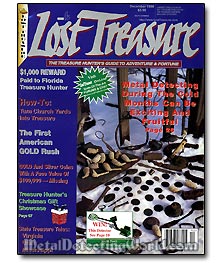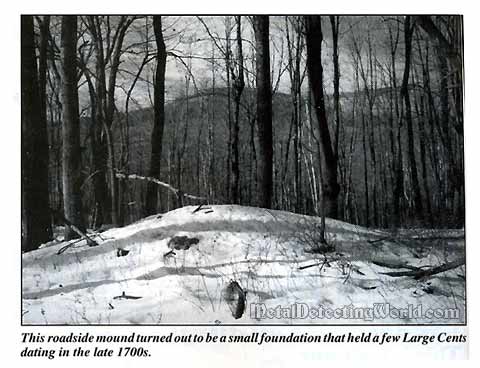My Article on Treasure Hunting Published in "Lost Treasure" Magazine
Metal Detecting the Obvious Sites Can Be Rewarding!
This article on metal detecting the obvious sites was published in the "Lost Treasure" magazine, on page 26, in December 1998. Even though this material was published a long while ago, it still contains some useful tips on research that will never become outdated.
"Searching The Obvious"
For many treasure hunters who live in the northern states of the country the wintertime is the time to do research and fight depressing moods in anticipation of the upcoming season. Sometimes we are lucky when the mild winter gives us a nice break; the grounds become snowless and the temperatures go up into the mid 40s. This adds some more days to the season of active treasure hunting.

Despite the short hours of the winter day's light, metal detecting during the cool months can be as exciting and fruitful as it is during the summer. You can make it happen if you search the most accessible sites situated along the roads - the "obvious" sites.
Since I found my first coin, a Mercury dime in a muddy hole five years ago, I have been addicted to the hobby so much that I sometimes feel guilty if I stay home on a warm and sunshiny day. During my first year of detecting, my excitement was growing up to the highest level until the winter came to Upstate New York where I live.
Not to get depressed, I decided to work out the possibilities of continuing my treasure hunting activity. By that time, the searching for hidden sites in the uninhabited areas had become the most interesting challenge to me. I did not stop doing that even after the first snow.
Soon I discovered that the winter landscape can be helpful in locating the most hidden "untouched" sites in remote areas. Sometimes, when the sky was overcast, the short winter days would become so dark that I could not take long hikes in the woods. Not to waste a metal detecting day, I decided to shift my focus onto the opposite - the obvious sites situated right off the local roads.
When I drove around observing the roadsides for the first time, I was pleasantly surprised by a number of interesting locations for metal detecting I spotted. I continued doing that for a while and later completed a long list of all potential spots I discovered. That list still keeps me busy. It is important to know that the winter season is the best time to locate the "remains of the past" situated along the roads.

During the summer, many of the obvious sites become unnoticeable as they are disguised by the overgrown vegetation or fallen trees and branches. During the winter, the snowy landscape "bleaches out" colorful vegetation and makes the signs of the abandoned homesteads, such as the remains of the stone walls, abandoned side roads, openings in the stone walls, the earth mounds and depressions, the single-standing trees and unusual vegetation, the overgrown shrubbery and driveways, more visible.
Usually the old foundations are located less than 20 feet away from the road. A few times, I had the same tricky situation: old colonial coins were buried so close to the county road that while digging them up, I got almost swirled by the whirlwinds created by the cars passing by.
Certainly most of the metal detecting sites have been searched by now. The question is "When?" Some of them are not obvious any longer after having been blended into the natural surroundings for many years.
If such "forgotten" spots were hunted last time in the 1960s when metal detectors were not as advanced as today, there is still a good chance in finding coins and relics at these locations. I have recently dug up an 1848 Large Cent, some colonial buttons and a sterling silver ring at the site littered with the old pull tabs. Because the archaic metal detectors did not have an advanced discrimination and could not effectively separate the targets' signals, the pull tabs easily masked the "goodies".
While driving on the rural roads many of us pass by the abandoned sites either without noticing them or thinking of them as being hunted out. This is one of the reasons I do not believe that any site can be hunted out completely. Every time I search the spot that is claimed to be cleaned out, I still "squeeze out" a few old coins.